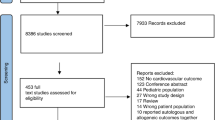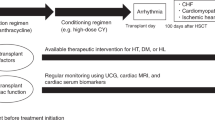Abstract
Hematopoietic stem cell transplantation (HSCT) treats disorders affecting patients of all ages. We studied the rate-corrected cardiac QT interval (QTc) in 995 consecutive children and adults undergoing HSCT at the University of Minnesota. We sought to (1) describe QTc before and after HSCT; (2) describe the change in QTc after HSCT; (3) identify factors affecting QTc and its change; and (4) scrutinize an ‘at risk’ sub-cohort with a long QTc before HSCT. Pre HSCT: 952 (96%) patients had an evaluable electrocardiography (ECG); median QTc was 426 ms and depended upon disease necessitating transplant. Post HSCT: 506 (51%) patients had an evaluable ECG; median QTc was 441 ms. Intrapatient QTc change: 490 (49%) evaluable patients showed median QTc change (pre to post HSCT) of +16 ms (P<0.0001). At risk group: 68 patients were ‘at risk’ (long pre-HSCT QTc). In some, ‘at-risk’ status trended toward predictive of post-transplant nonrelapse mortality. QTc interval prolongation is evident in a large, diverse cohort undergoing HSCT at our institution. Prospective studies of this patient population may be warranted, particularly for ‘at-risk’ patients who demonstrate significant QTc prolongation both pre and post HSCT.
This is a preview of subscription content, access via your institution
Access options
Subscribe to this journal
Receive 12 print issues and online access
$259.00 per year
only $21.58 per issue
Buy this article
- Purchase on Springer Link
- Instant access to full article PDF
Prices may be subject to local taxes which are calculated during checkout


Similar content being viewed by others
References
Ayala E, Tomblyn M . Hematopoietic cell transplantation for lymphomas. Cancer Control 2011; 18: 246–257.
Carpenter PA, Meshinchi S, Davies SM . Transplantation for AML in children. Biol Blood Marrow Transplant 2012; 18: S33–S39.
Mehta P, Locatelli F, Stary J, Smith FO . Bone marrow transplantation for inherited bone marrow failure syndromes. Pediatr Clin North Am 2010; 57: 147–170.
Orchard PJ, Blazar BR, Wagner J, Charnas L, Krivit W, Tolar J . Hematopoietic cell therapy for metabolic disease. J Pediatr 2007; 151: 340–346.
Smith AR, Gross TG, Baker KS . Transplant outcomes for primary immunodeficiency disease. Semin Hematol 2010; 47: 79–85.
Tolar J, Mehta PA, Walters MC . Hematopoietic cell transplantation for nonmalignant disorders. Biol Blood Marrow Transplant 2012; 18: S166–S171.
National Marrow Donor Program [internet]. Minneapolis: National Marrow Donor Program; c.1996–2014 [cited 2014 Dec]. Available from http://www.marrow.org.
Appelbaum FR, Thomas E . Thomas' Hematopoietic Cell Transplantation: Stem Cell Transplantation. 4th edn Wiley-Blackwell: Oxford, UK, 2009.
Robenshtok E, Gafter-Gvili A, Goldberg E, Weinberger M, Yeshurun M, Leibovici L et al. Antifungal prophylaxis in cancer patients after chemotherapy or hematopoietic stem-cell transplantation: systematic review and meta-analysis. J Clin Oncol 2007; 25: 5471–5489.
Alousi A, de Lima M . Reduced-intensity conditioning allogeneic hematopoietic stem cell transplantation. Clin Adv Hematol Oncol 2007; 5: 560–570.
Satwani P, Cooper N, Rao K, Veys P, Amrolia P . Reduced intensity conditioning and allogeneic stem cell transplantation in childhood malignant and nonmalignant diseases. Bone Marrow Transplant 2008; 41: 173–182.
Shaw BE, Arguello R, Garcia-Sepulveda CA, Madrigal JA . The impact of HLA genotyping on survival following unrelated donor haematopoietic stem cell transplantation. Br J Haematol 2010; 150: 251–258.
Mohty M, Malard F, Savani BN . High-dose total body irradiation and myeloablative conditioning before allogeneic hematopoietic cell transplantation: time to rethink? Biol Blood Marrow Transplant 2014 e-pub ahead of print, 20 September 2014: doi: 0.1016/j.bbmt.2014.09.010.
Blume KG, Krance RA . The evaluation and counseling of candidates for hematopoietic cell transplantation. Appelbaum FR, Forman SJ, Negrin RS, Blume KG (eds.) Thomas' Hematopoietic Cell Transplantation: Stem Cell Transplantation, Fourth Edition. Wiley-Blackwell: Hoboken, NJ, USA, 2004, 443–460.
Levine E, Rosero SZ, Budzikowski AS, Moss AJ, Zareba W, Daubert JP . Congenital long QT syndrome: considerations for primary care physicians. Cleve Clin J Med 2008; 75: 591–600.
Lankipalli RS, Zhu T, Guo D, Yan GX . Mechanisms underlying arrhythmogenesis in long QT syndrome. J Electrocardiol 2005; 38: 69–73.
Goldenberg I, Zareba W, Moss AJ . Long QT Syndrome. Curr Probl Cardiol 2008; 33: 629–694.
Roden DM . Drug-induced prolongation of the QT interval. N Engl J Med 2004; 350: 1013–1022.
Amin AS, Tan HL, Wilde AA . Cardiac ion channels in health and disease. Heart Rhythm 2010; 7: 117–126.
Zareba W . Drug induced QT prolongation. Cardiol J 2007; 14: 523–533.
Sorror ML, Maris MB, Storb R, Baron F, Sandmaier BM, Maloney DG et al. Hematopoietic cell transplantation (HCT)-specific comorbidity index: a new tool for risk assessment before allogeneic HCT. Blood 2005; 106: 2912–2919.
Lin DY . Non-parametric inference for cumulative incidence functions in competing risks studies. Stat Med 1997; 16: 901–910.
Credible Meds [internet]. 2014. AZCERT, Inc.: Oro Valley, AZ, USA, (accessed 2014 Oct). Available from: http://www.crediblemeds.org.
Moss AJ . Gender differences in ECG parameters and their clinical implications. Ann Noninvasive Electrocardiol 2010; 15: 1–2.
Moss AJ . Measurement of the QT interval and the risk associated with QTc interval prolongation: a review. Am J Cardiol 1993; 72: 23B–25B.
Bender KS, Shematek JP, Leventhal BG, Kan JS . QT interval prolongation associated with anthracycline cardiotoxicity. J Pediatr 1984; 105: 442–444.
Schwartz CL, Hobbie WL, Truesdell S, Constine LC, Clark EB . Corrected QT interval prolongation in anthracycline-treated survivors of childhood cancer. J Clin Oncol 1993; 11: 1906–1910.
Bagnes C, Panchuk PN, Recondo G . Antineoplastic chemotherapy induced QTc prolongation. Curr Drug Saf 2010; 5: 93–96.
Yusuf SW, Razeghi P, Yeh ET . The diagnosis and management of cardiovascular disease in cancer patients. Curr Probl Cardiol 2008; 33: 163–196.
Hazarika M, Jiang X, Liu Q, Lee SL, Ramchandani R, Garnett C et al. Tasigna for chronic and accelerated phase Philadelphia chromosome—positive chronic myelogenous leukemia resistant to or intolerant of imatinib. Clin Cancer Res 2008; 14: 5325–5331.
Johnson FM, Agrawal S, Burris H, Rosen L, Dhillon N, Hong D et al. Phase 1 pharmacokinetic and drug-interaction study of dasatinib in patients with advanced solid tumors. Cancer 2010; 116: 1582–1591.
Manosuthi W, Sungkanuparph S, Anekthananon T, Supparatpinyo K, Nolen TL, Zimmer LO et al. Effect of high-dose fluconazole on QT interval in patients with human immunodeficiency virus (HIV)-associated cryptococcal meningitis. Int J Antimicrob Agents 2009; 34: 494–496.
Alkan Y, Haefeli WE, Burhenne J, Stein J, Yaniv I, Shalit I, Voriconazole-induced QT . interval prolongation and ventricular tachycardia: a non-concentration-dependent adverse effect. Clin Infect Dis 2004; 39: e49–e52.
Braunlin E, Mackey-Bojack S, Panoskaltsis-Mortari A, Berry JM, McElmurry RT, Riddle M et al. Cardiac functional and histopathologic findings in humans and mice with mucopolysaccharidosis type I: implications for assessment of therapeutic interventions in hurler syndrome. Pediatr Res 2006; 59: 27–32.
Porthan K, Viitasalo M, Jula A, Reunanen A, Rapola J, Väänänen H et al. Predictive value of electrocardiographic QT interval and T-wave morphology parameters for all-cause and cardiovascular mortality in a general population sample. Heart Rhythm 2009; 6: 1202–1208.
Moss AJ, Robinson JL . Long QT syndrome. Heart Dis Stroke 1992; 1: 309–314.
Nakamae H, Hino M, Akahori M, Terada Y, Yamane T, Ohta K et al. Predictive value of QT dispersion for acute heart failure after autologous and allogeneic hematopoietic stem cell transplantation. Am J Hematol 2004; 76: 1–7.
Motoki N, Shimizu T, Akazawa Y, Saito S, Tanaka M, Yanagisawa R et al. Increased pretransplant QT dispersion as a risk factor for the development of cardiac complications during and after preparative conditioning for pediatric allogeneic hematopoietic stem cell transplantation. Pediatr Transplant 2010; 14: 986–992.
Goldsmith YB, Liu J, Chou J, Hoffman J, Comenzo RL, Steingart RM . Frequencies and types of arrhythmias in patients with systemic light-chain amyloidosis with cardiac involvement undergoing stem cell transplantation on telemetry monitoring. Am J Cardiol 2009; 104: 990–994.
Acknowledgements
Biostatistical support for this research publication was supported by NIH grants P30 CA77598 and P01 CA65493 utilizing the Biostatistics and Bioinformatics Core shared resource of the Masonic Cancer Center, University of Minnesota and by the by the National Center for Advancing Translational Sciences of the National Institutes of Health Award Number 8UL1TR000114-02. The content is solely the responsibility of the authors and does not necessarily represent the official views of the National Institutes of Health.
Author Contributions
WPM was involved in the concept/design, data collection, data analysis and writing/revision of the manuscript. RS performed data collection, data analysis and statistical support. PD was involved in the concept/design, data analysis and critical revision of manuscript.
Author information
Authors and Affiliations
Corresponding author
Ethics declarations
Competing interests
The authors declare no conflict of interest.
Rights and permissions
About this article
Cite this article
Miller, W., Shanley, R. & Dorostkar, P. Cardiac QTc interval characteristics before and after hematopoietic stem cell transplantation: an analysis of 995 consecutive patients at a single center. Bone Marrow Transplant 50, 954–960 (2015). https://doi.org/10.1038/bmt.2015.64
Received:
Revised:
Accepted:
Published:
Issue Date:
DOI: https://doi.org/10.1038/bmt.2015.64
This article is cited by
-
Acquired long QT syndrome during conditioning for allogeneic stem cell transplantation—are we aware of this side effect?
Annals of Hematology (2018)
-
Evaluation of the impact of treatment with hematopoietic stem cells transplantation (HSCT) on biochemical markers of heart function and novel electrocardiographic markers of repolarization in patients with hematological malignancies
Medical Oncology (2018)



